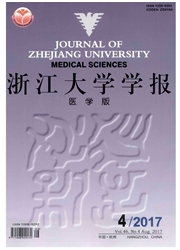

 中文摘要:
中文摘要:
目的:研究抗氧化性诱导剂(激活剂)叔丁基对苯二酚(tert-butylhydroquinone,tBHQ)和莱菔硫烷[1-异硫氰酸-(4R,S)-(甲基亚磺酰基)丁烷](sulforaphane,SFN)对人结肠癌细胞株Caco2的Nrf2-ARE信号通路的影响。方法:选取不同的时间点,分别用20μmol/L tBHQ和5μmol/L SFN处理Caco2细胞,从蛋白质水平、mRNA水平和蛋白质定位3个方面,分别用Westernblotting、real-time PCR和免疫荧光染色(immunoflourescence staining,IF)方法来检测Nrf2以及其调控基因AKR1C1和NQO1(Western blotting,real-time PCR)表达的变化。结果:细胞核中Nrf2基因表达的最佳时间点为加药诱导后8 h,细胞质中Nrf2调控基因AKR1C1和NQO1表达的最佳时间点为加药诱导后16 h。tBHQ的诱导作用在撤去之后仍能持续4 h。结论:本研究使用激活剂tBHQ和SFN对Caco2细胞的Nrf2-ARE信号通路进行诱导,取得了最佳的诱导时间点,并研究了撤去tBHQ后持续诱导时间,为今后在肿瘤化学预防研究中,筛选合适的激活剂及其剂量和使用次数提供了重要依据,也为研究Nrf2-ARE信号通路的抑制剂提供了重要信息。
 英文摘要:
英文摘要:
Objective: To investigate the effect of tBHQ and sulforaphane on the protein expression in Nrf2-ARE signaling pathway of Caco2 cells.Methods: Human colorectal carcinoma Caco2 cells were treated with 20 μmol/L tBHQ and 5 μmol/L sulforaphane(SFN) respectively.Real time PCR,Western blotting and immunoflourescence staining(IF) were performed to measure the target gene expression.Results: Nrf2,AKR1C1 and NQO1 protein expressions were increased time-dependently in Caco2 cells after treatment with tBHQ and SFN.Time-course experiments showed that tBHQ and SFN increased the accumulation of Nrf2,and concomitantly increased the protein levels of AKR1C1 and NQO1.Real-time PCR and Western blotting showed that tBHQ and SFN significantly increased the expression of Nrf2 at 8h after the treatment,and AKR1C1 and NQO1 at 16 h.Confocal microscopy technique showed that Nrf2 accumulated in the nucleus at 6-8 h after treatment with tBHQ.After 1 h treatment with tBHQ the nuclear Nrf2 maintained at elevated level for at least 4 h with tBHQ withdrawn.Conclusions: tBHQ and SFN induced nuclear accumulation of Nrf2 and activated Nrf2-dependent regulation of ARE-mediated gene expression in Caco2 cells.In addition,the results provide experimental evidence for choosing the dose and frequency of the inducer in cancer chemoprevention study and in developing inhibitors of Nrf2-ARE signaling pathway.
 同期刊论文项目
同期刊论文项目
 同项目期刊论文
同项目期刊论文
 期刊信息
期刊信息
